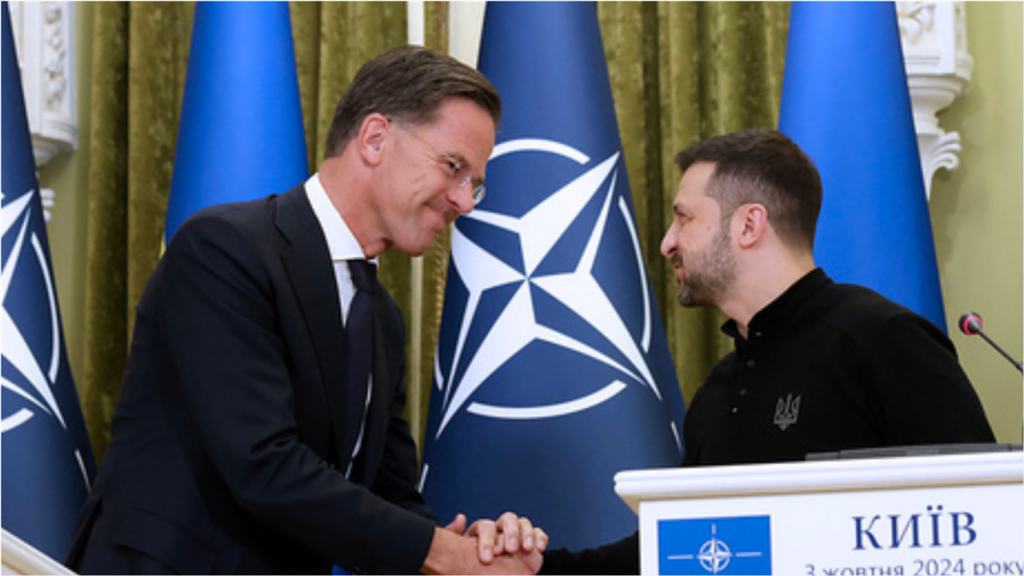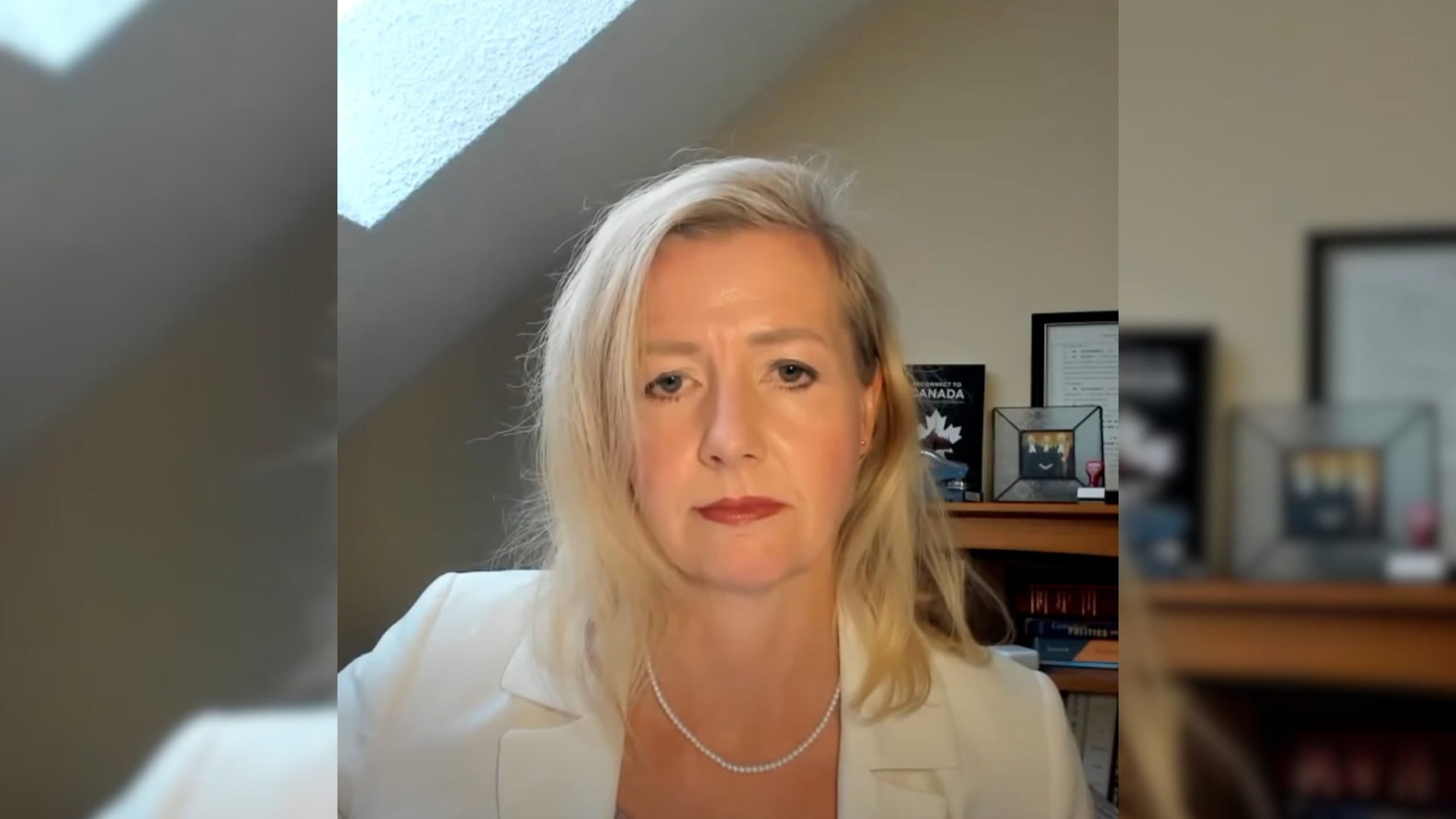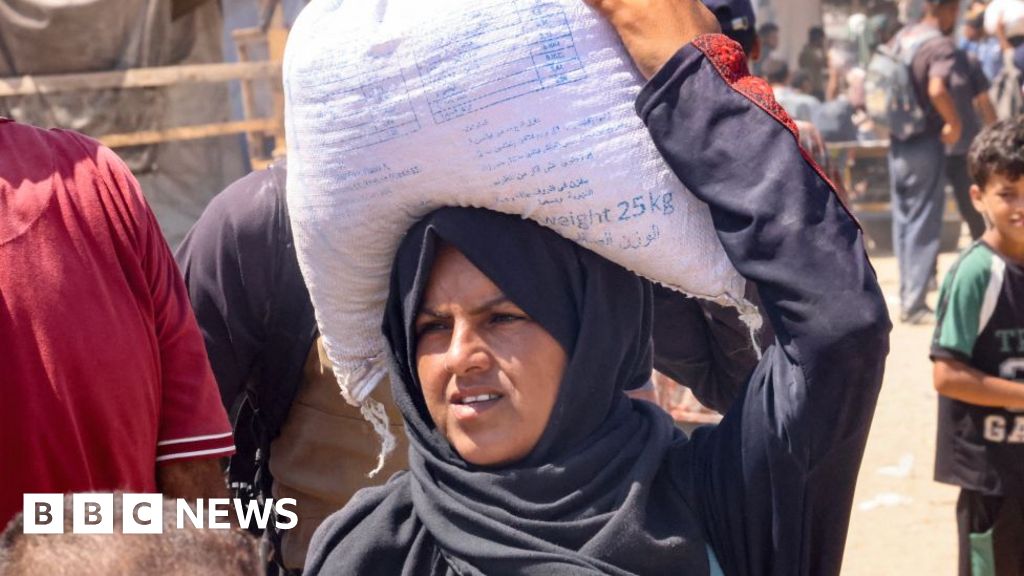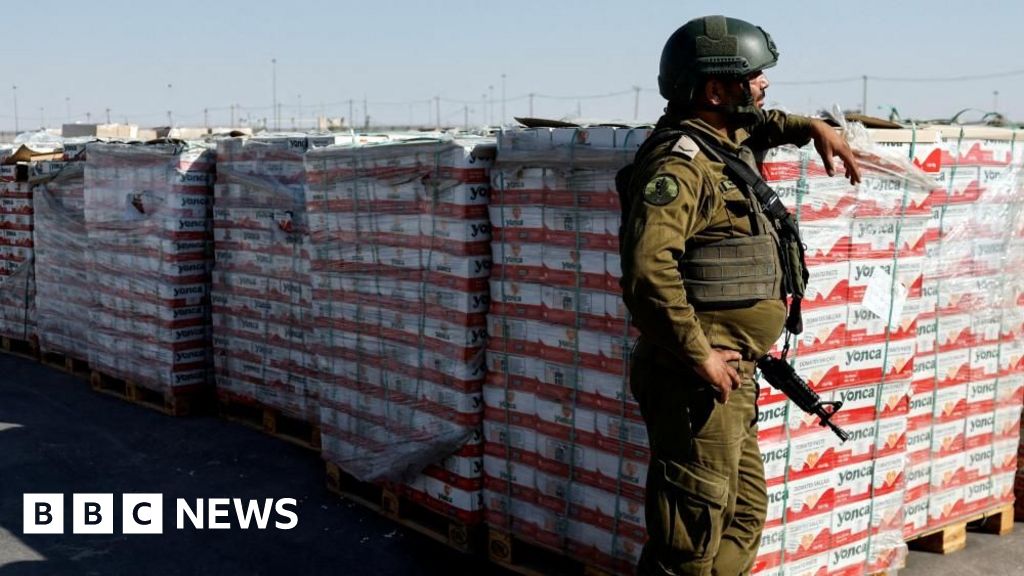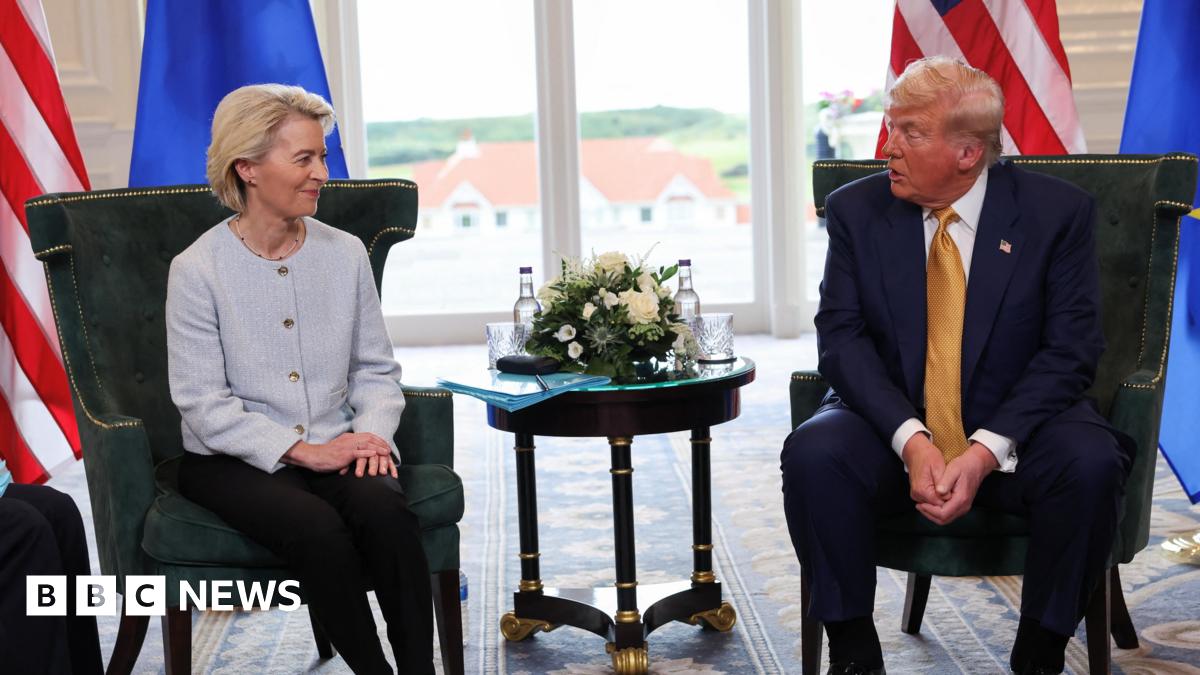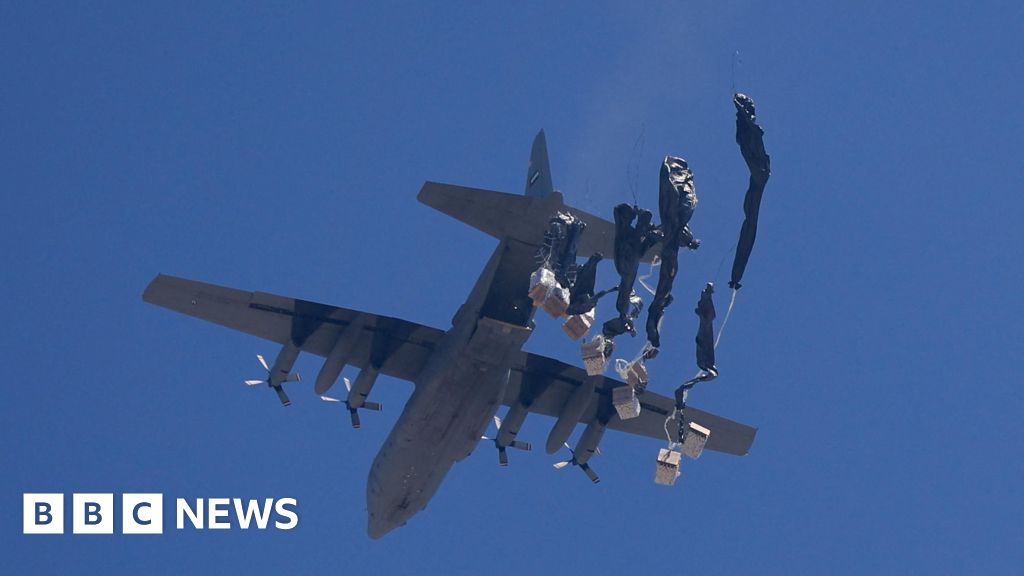Jordan and UAE begin air drops into Gaza after Israel announced series of aid measures – follow live
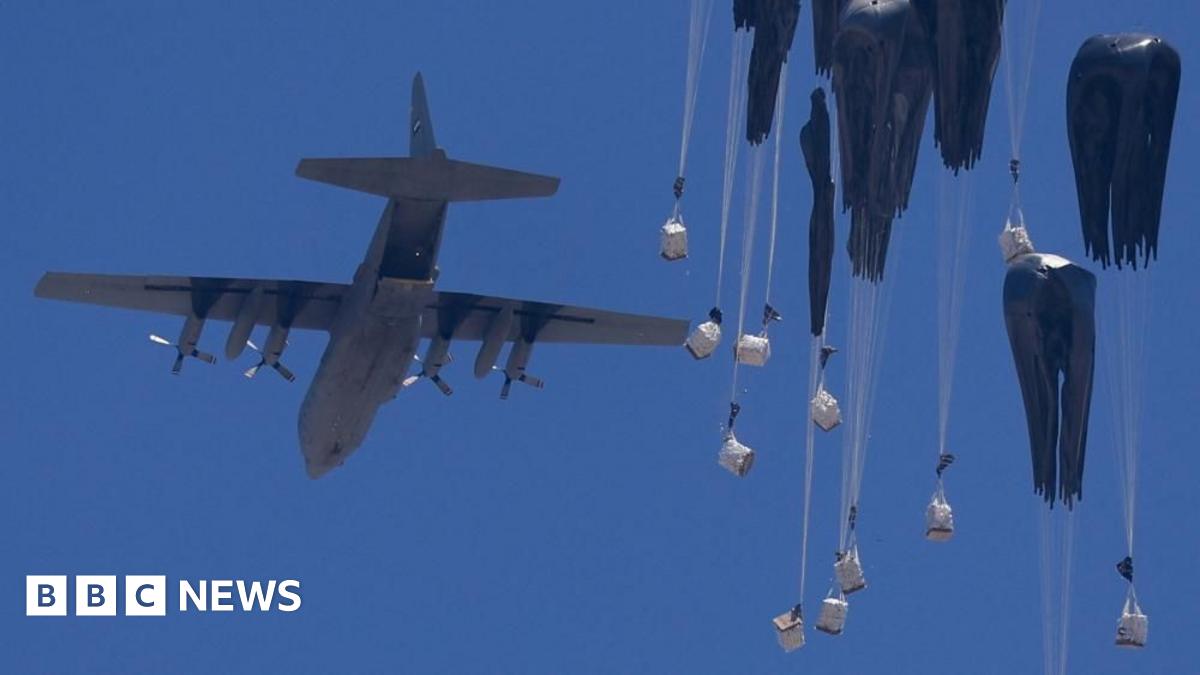

Video appears to show IDF struck apartment in Gaza City after pause beganpublished at 17:42 British Summer Time
By Benedict Garman
Earlier we reported that an Israeli strike appears to have hit a residential apartment in Gaza City shortly after the Israeli military announced a humanitarian pause in the area.
The BBC approached the IDF for comment on the strike and provided the military with coordinates of where it occurred. The IDF says that it checked the coordinates and was not aware of a strike in the area, or in the surrounding area.
We’ve since verified two videos of the aftermath of this apparent strike, as well as a photograph showing damage to the apartment building.
One video is filmed outside and shows people gathered in the road and bodies being pulled from rubble. A man runs from the scene carrying a little girl covered in blood. A motionless body is loaded into a wheelbarrow and rushed away.
A separate video is filmed from a blood-stained room on one of the upper floors inside – identifiable from the view out of the window – while a photo shows scorch marks surrounding a large hole in the wall and a broken window.
By matching the visible buildings and trees to satellite imagery, we’ve geolocated the imagery to Midhat Al Wahidy Street in Al-Rimal district, which confirms the strike happened in an area where the military pause was meant to be underway.
The area is home to thousands of displaced people.
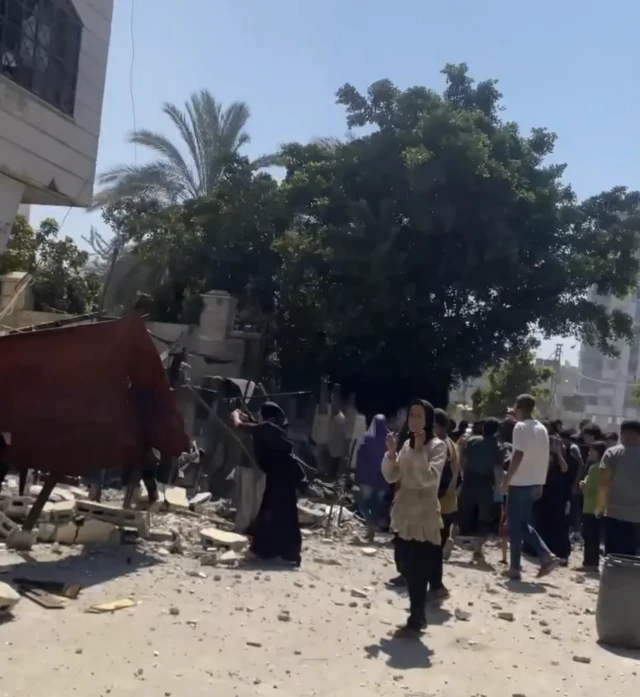 Image source, Instagram
Image source, Instagram
Gazans worry international attention on starvation will fadepublished at 17:18 British Summer Time
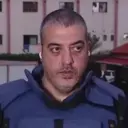 Rushdi Abualouf
Rushdi Abualouf
BBC News Gaza correspondent in Istanbul
Medical experts in Gaza say malnutrition is becoming widespread especially among children and those with specific dietary needs.
One of the most affected groups are those with gluten intolerance, who are unable to consume wheat-based products like bread, which now make up the bulk of available food.
“My wife and one of my five children have coeliac disease,” says Rami Taha, who lives in central Gaza. “Before the war, I used to buy them gluten-free products. Now, there is nothing. I have to take them to the hospital every few days just to get IV fluids.”
Many Gazans say they worry that international attention will fade once a few symbolic aid deliveries are made.
“This is not a permanent solution, it’s like giving a painkillers to cancer patient without treating them” says Ahmad Taha, a shopkeeper in northern Gaza.
As efforts to revive broader ceasefire seems faltering, the people of Gaza remain trapped between hope and despair thankful for any aid, but yearning for a lasting peace.
Photos show Gazans at distribution point as aid trucks enter Strippublished at 16:49 British Summer Time
We’re beginning to see photos of trucks carrying supplies crossing into the Strip.
Images show chaotic scenes as lorries are surrounded by crowds of Palestinians as they seek aid that are moving into Gaza through humanitarian corridors.
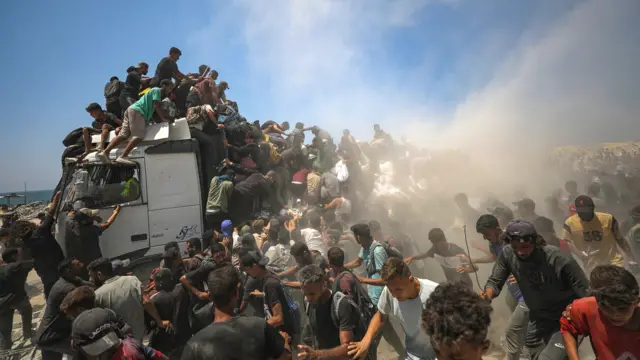 Image source, EPA
Image source, EPA
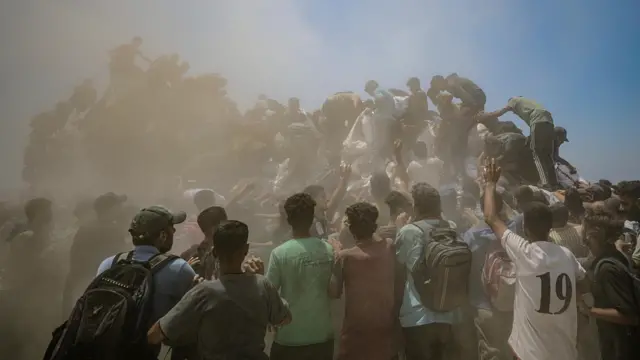 Image source, EPA
Image source, EPA
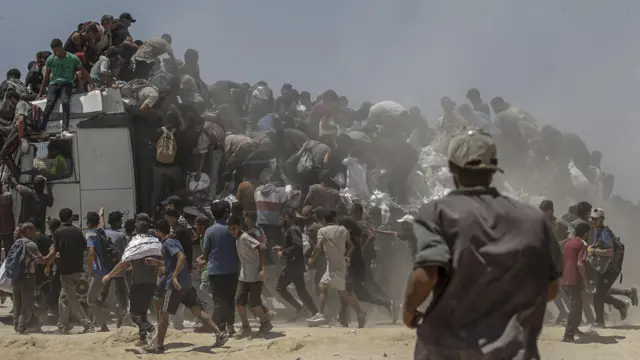 Image source, EPA
Image source, EPA
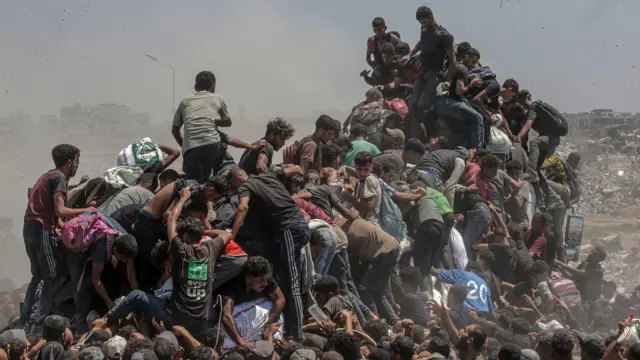 Image source, EPA
Image source, EPA

Israel’s aid measures a gesture to allies horrified by Gaza starvationpublished at 16:26 British Summer Time
 Jeremy Bowen
Jeremy Bowen
International Editor
While Israel continues to insist it is not responsible for the humanitarian catastrophe in Gaza and does not impose restrictions on aid entering Gaza, those claims are not accepted by its close allies in Europe, or the United Nations and other agencies active in Gaza.
The new measures might be a tacit admission by the Israelis that they need to do more.
More likely they are a gesture to allies who have issued strong statements blaming Israel for starvation in Gaza.
Israel released grainy footage of a transport plane dropping pallets of aid into Gaza. The IDF said it had delivered seven packages of aid containing flour, sugar and tinned food.
Professionals involved in relief operations regard dropping aid from the sky as a last resort. They use it when any other access is impossible. That’s not the case in Gaza. A short drive north is Ashdod, Israel’s modern container port. A few more hours away is the Jordanian border, which has been used regularly as a supply line for aid for Gaza.
Gaza was one of the world’s most densely populated places before the war when the population of more than two million Palestinians had access to the entire strip. In British terms, the Gaza Strip is slightly smaller than the Isle of Wight. Compared to American cities, it’s roughly the size of Philadelphia or Detroit.
Now Israel has forced most of Gaza’s people into a tiny area on the southern coast, amounting to around 17% of Gaza’s land. Most of them live in densely packed tents. It is not clear if there is even an open space for despatchers high in the sky to aim at.
Pallets of aid dropped by parachute often land far from the people who need it.
Each pallet will be fought over by desperate men trying to get food for their families, and by criminal elements who will want to sell it for profit.
- Read more from Jeremey Bowen about Israel’s response to Gaza’s aid crisis here
‘Most aid packages dropped from the sky’ landed in militarised zones, Gazan tells BBCpublished at 16:14 British Summer Time

Imad Kudaya is a local journalist in Gaza and from al-Mawasi, in the south of the Strip, he has been telling BBC News about the recent air drops and the dangers involved for those on the ground.
“Most of those packages that have dropped from the sky – they have fallen in …places where if you go there you will put yourself in a very big risk.
“Those place are evacuated and under Israeli control – so it is risky.”
Imad says there is “good news” from the Egyptian Red Crescent who say that more aid trucks are going to be allowed into the Strip.
How world leaders are responding to Israel’s new Gaza aid measurespublished at 15:55 British Summer Time
We heard a little earlier from Israeli PM Netanyahu about the aid entering Gaza. Let’s take a quick look now on how the international community has responded to situation in Gaza today.
- UK Foreign Secretary David Lammy says Israel’s “temporary pause” of its military operations in parts of Gaza is “essential”, but the measure alone can’t “alleviate the suffering” of Gaza’s population
- German Chancellor Friedrich Merz says he’s urged Israeli Prime Minister Benjamin Netanyahu in a phone call to bring about an immediate ceasefire and allow aid to reach people in Gaza
- Pope Leo XIV has expressed particular concern for the “extremely grave humanitarian situation in Gaza”, where people are “crushed by hunger and continue to be exposed to violence and death”, according to Vatican News, the Holy See’s official news portal
- South Africa’s President Cyril Ramaphosa says at a summit that they “condemn in the strongest terms” what they call the “genocide” committed by Israel against Palestinians, and call on Israel to allow aid to be distributed
- Spanish Foreign Minister José Manuel Albares says the “induced famine in Gaza is a disgrace”, adding that Spain is ready to send “everything necessary to Gaza”, and calls for Israel to allow free passage of aid to the war-torn strip
A look at the issues the UN faces moving aid through Gazapublished at 15:37 British Summer Time
Aid agencies operating in Gaza say it is hard to distribute aid, even when it is inside the territory.
Last week, Israel said hundreds of trucks worth of aid supplies were already inside the Gaza border and awaiting distribution. But UN aid agencies say they need permission from the Israeli army to use travel routes, for safety reasons.
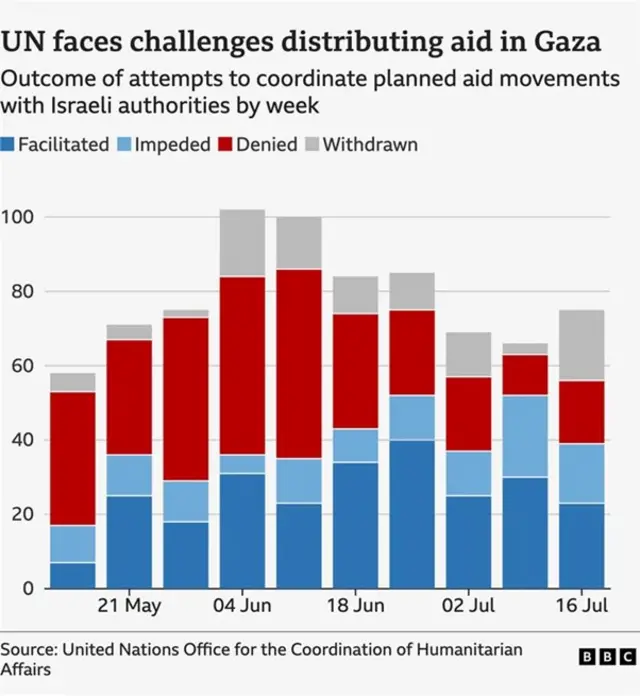
The above graphic – using data supplied by the UN Office for the Coordination of Humanitarian Affairs – shows the number of times Israel has denied permission for aid trucks to move beyond the border crossings. The red bars show the number of times that permission was denied.
There have been growing warnings of widespread hunger since Israel cut off all supplies to Gaza in March, saying it wanted to put pressure on Hamas to release the hostages.
Israel resumed the aid supply May, launching the Gaza Humanitarian Foundation (GHF) – staffed by private US contractors – saying it wanted to cut Hamas out of the aid distribution system. But hundreds of people have been killed trying to access food at or near these sites.
UN agencies and NGOs have warned of widespread hunger. The World Health Organisation warns of “mass starvation”, while the World Food Programme says one in three people are going for days without eating.
An Israeli government spokesman told the BBC last week the food shortages were “engineered by Hamas.”
Netanyahu: ‘No more excuses’ from UN about aid not entering Gazapublished at 15:17 British Summer Time
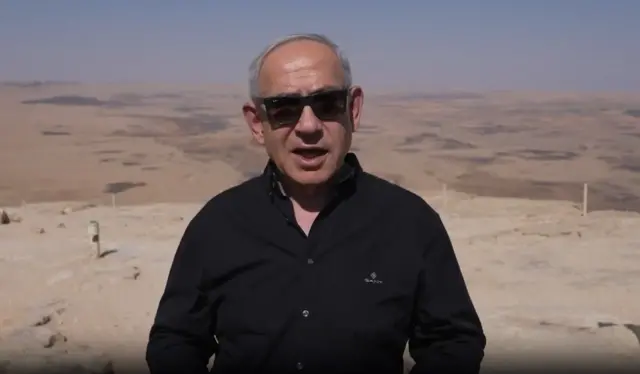 Image source, GPO
Image source, GPO
Israel’s Prime Minister Benjamin Netanyahu has made his first comments since the military announced a series of measures to boost humanitarian aid into Gaza.
In a video statement, he says that while Israel continues its fighting in Gaza and negotiations with Hamas, the country has got to allow the entry of “minimal” humanitarian supplies.
The prime minister says that Israel has always allowed aid into Gaza, but adds that the UN has bamed his government for the crisis Palestinians are facing.
“There are secure routes. There have always been, but today it’s official. There will be no more excuses,” the Israeli leader says, during a visit to an air base.
“We will continue to fight and we will continue to act until we achieve all of our war goals – until complete victory.”
MSF: Gaza humanitarian pause ‘about time’ but ‘not enough’published at 15:03 British Summer Time
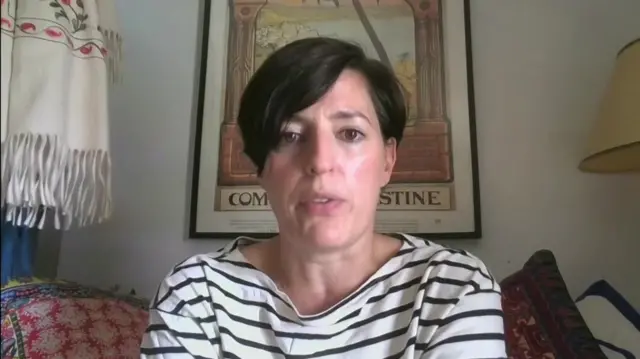 Image source, Reuters
Image source, Reuters
Médecins Sans Frontières’s (MSF) emergency operations director says news of a pause in fighting in some parts of Gaza is “about time”, but warns new aid measures announced by Israel today are still “not enough” to combat fears of widespread malnutrition in the Strip.
“After five months of starvation, people need to be sure that they are going to be receiving something at the end,” Amande Bazerolle tells the Reuters news agency.
As well as the pause in fighting and humanitarian corridors announced by the IDF, Bazerolle suggests there should be a “distribution list so that everybody knows that they’re going to receive their own parcel”.
And, with the Hamas-run health ministry reporting that over 100 people have already died as a result of malnutrition, Bazerolle warns there will be “life-long consequences” for the health of Gazans.
Despite this, the MSF representative is positive that they’ll now be able to treat more people due to the pause in fighting – which the IDF said earlier will take place for humanitarian purposes from 10:00 to 20:00 (07:00-17:00 GMT).
“With enough supply of therapeutic food, we’re going to be able to treat more people, and we are hoping that during those ten hours per day there will be no operation, and we can move towards those people who are too sick and tired to reach us,” Bazerolle says.
UN agencies welcome temporary daily pause of Israeli offensive in parts of Gazapublished at 14:45 British Summer Time
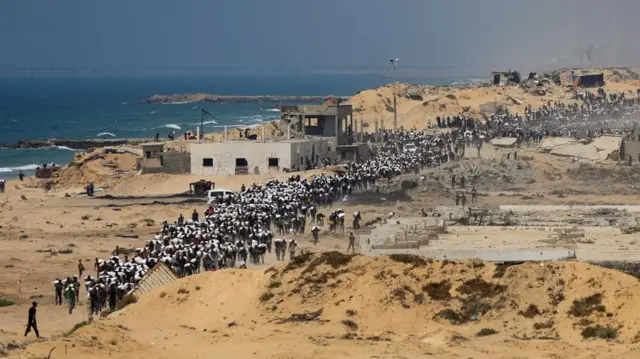 Image source, Reuters
Image source, Reuters
Unicef says it welcomes Israel’s announcement that it will implement “most urgently needed humanitarian pauses” to boost aid in Gaza.
“This is an opportunity to begin to reverse this catastrophe and save lives,” the UN body says.
Unicef also says that it could do much more if “additional designated humanitarian corridors are created to facilitate the movement of our convoys – as well as commercial trucks, which are essential”.
This follows comments from another UN body, the World Food Programme (WFP), which also spoke positively about Israel’s pause in military action in parts of Gaza and the creation of humanitarian corridors.
UN emergency relief coordinator Tom Fletcher also welcomed the announcement earlier.
He says he is “in contact with our teams on the ground who will do all we can to reach as many starving people as we can in this window”.
Governments should put pressure on Israel to end the war – UN high commissionerpublished at 14:26 British Summer Time
 Image source, EPA
Image source, EPA
UN High Commissioner for Human Rights Volker Türk has called on governments around the world to use their leverage and put pressure on Israel to end the war in Gaza.
In a video statement, external released ahead of a conference on Palestine opening in New York tomorrow, he says that every day we see “more destruction, more killings, and the further dehumanization of Palestinians”.
He says Israel has “obligations” to ensure that food and lifesaving necessities are provided to the population, and all countries should take “concrete steps” to make sure that happens.
He calls for the delivery of “massive” humanitarian aid to Gaza, as well as an “immediate, permanent ceasefire [and] the immediate and unconditional release of all hostages”.
Jordan and UAE planes drop 25 tonnes of aid over Gazapublished at 14:09 British Summer Time
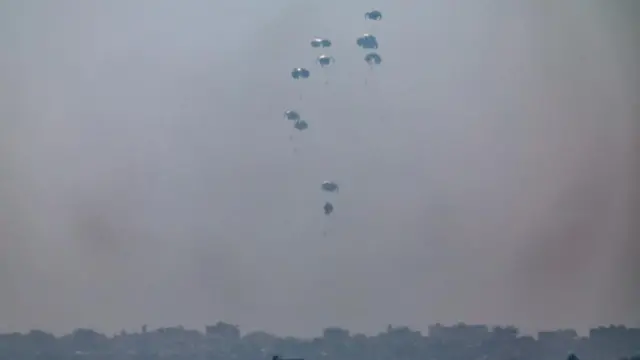 Image source, EPA
Image source, EPA
A little while ago, Jordanian state TV reported that the Royal Jordanian Air Force has been involved in an operation with the United Arab Emirates to drop “25 tonnes of food aid and essential humanitarian supplies” into Gaza.
Two Jordanian C-130 planes and one United Arab Emirate aircraft were involved in the mission and targeted several locations within the Gaza Strip, the report says.
Jordanian state TV adds that the latest delivery of aid brings the total number of Jordanian airdrops since the start of the war in Gaza has reached 127.
- For context, it says additionally, 267 airdrops have been carried out in cooperation with partner nations
Price of flour falls as Gazans anxiously await aid shipmentspublished at 13:42 British Summer Time
 Rushdi Abualouf
Rushdi Abualouf
BBC News Gaza correspondent in Istanbul
Gazans are anxiously awaiting the entry of trucks of food aid in Gaza – but it’s still uncertain when the aid will arrive.
Dozens of empty trucks were seen heading in convoys toward three different locations: Zikim crossing in northern Gaza, Kissufim crossing in central Gaza, and the Kerem Shalom crossing in the far south-east of the Strip.
Meanwhile, local markets witnessed increased activity as merchants rushed to sell food items they had previously been hoarding.
Prices remain extremely high but have dropped slightly compared to previous days.The price of a kilogram of flour has fallen to $15 (£11) down from $85 (£63) just four days ago.
How much food can air drops actually deliver to Gazans?published at 13:18 British Summer Time
 Joe Inwood
Joe Inwood
World news correspondent
There’s been much fanfare about the idea of air drops,with government press releases soon followed by dramatic images of aid driftingthrough the sky and into Gaza.
But, how much food can they actually deliver? We’ve beenlooking at the numbers and the answer is not enough, on their own.
When they flew similar missions last year, each C-130cargo plane carried about 12,500 “meals” per trip, according to officialfigures released by US Central Command.
It’s worth pointing out we don’t know exactly whatdefinition they used for a meal.
But, at that rate, approximately 160 flights would beneeded just to provide a single meal for each of Gaza’s approximately twomillion people.
Given that the Jordanian and UAE Air Forces are thoughtto have about 20 C-130s between them, the challenges of using air drops as away of feeding the population are evident.
It’s also why the potentially far more significant partof last night’s announcement is the news that “humanitarian corridors” will beopening.
If, that is, they operate in a way that allows truckscarrying aid into the Gaza Strip in real numbers.
UAE and Jordan begin fresh aid air drops over Gazapublished at 13:07 British Summer Time
Breaking
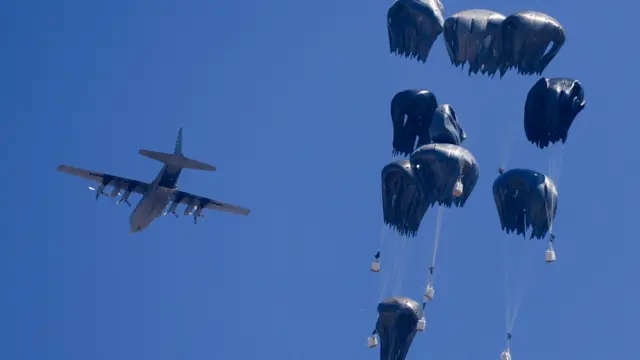 Image source, Reuters
Image source, Reuters
We’re starting to see reports that the United Arab Emirates (UAE) and Jordan have begun a fresh round of air drops over Gaza.
A little earlier, we reported that an air drop was expected at some point between 12:00 local time (10:00 BST) and 14:00 local time (12:00 BST) in northern Gaza, according to an Emirati official.
New water pipeline between Egypt and Gaza to serve 600,000 Palestinians – Cogatpublished at 13:03 British Summer Time
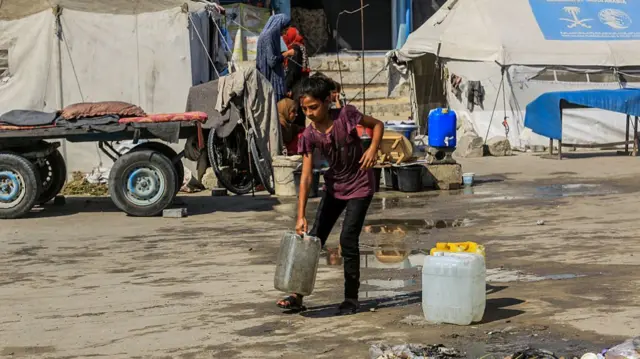 Image source, Getty Images
Image source, Getty Images
A new clean water pipeline has been approved between Egypt and Gaza, Cogat, the Israeli military body which oversees the entry of aid into the Strip, has said.
The new pipeline will flow from a desalination facility in Egypt to the Al-Mawasi area along Gaza’s coastline.
“The pipeline is intended to serve approximately 600,000 residents in the area and will operate independently of Israel’s water pipelines,” Cogat says.
“Construction of the pipeline will commence in the coming days and is expected to continue for several weeks.”
It comes as the Israel Defense Forces (IDF) also announced on Saturday that a power line from Israel to a Gaza desalination plant has been reconnected, which it suggested would boost “daily water output to 20,000 cubic metres”.
Gazans welcome humanitarian pause but call for long-term solutionpublished at 12:50 British Summer Time
 Rushdi Abualouf
Rushdi Abualouf
Gaza correspondent in Istanbul
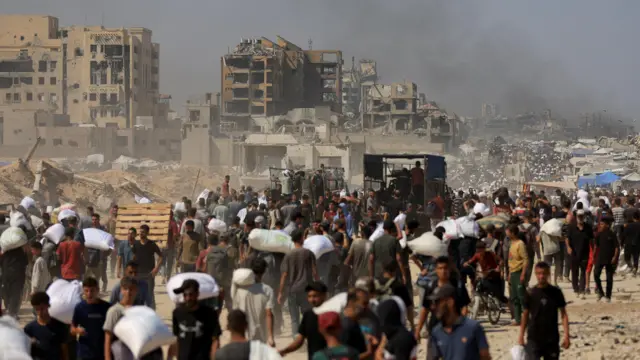 Image source, Reuters
Image source, Reuters
Residents of Gaza have cautiously welcomed reports of a temporary humanitarian pause allowing food and medicine to enter the besieged enclave, but many say the relief must be the beginning of a broader, lasting solution to the deepening crisis.
For months, Gaza’s population of more than two million has faced extreme shortages of food, clean water, and basic medical supplies as bombardment and border closures have brought daily life to a standstill.
“Of course I feel a bit of hope again, but also worried that starvation would continue once the pause is over,” says Rasha Al-Sheikh Khalil, a mother of four in Gaza City.
“One convoy of aid or a few air drop packages won’t be enough. We need a real solution an end to this nightmare an end to the war,” she says.
“This isn’t just about quantity of food it’s about quality,” says Neveen Saleh, a mother of six.
“We haven’t eaten a single fresh fruit or vegetable in four months. There’s no chicken, no meat, no eggs. All we have are canned foods that are often expired and flour.”
Gaza health ministry: Total killed since war began rises to 59,821published at 12:38 British Summer Time
The total number killed and injured in Gaza
In today’s casualties update, the Hamas-run health ministry in Gaza says 88 people have been killed and a further 374 injured due to “Israeli aggression” in the past 24 hours.
It says this brings the death toll to 59,821, with another 144,851 injured since the war began on 7 October 2023.
Deaths and injuries at aid collection points
The health ministry also says that an additional 11 people have been killed while collecting aid in the last day. It adds that 36 more were injured.
The health ministry says this brings the total number of deaths at such locations to 1,132 and the number injured to 7,521.
Malnutrition deaths
As we reported a little earlier, the health ministry in Gaza says that six new deaths due to malnutrition have been recorded in the past 24 hours.
This, it says, brings the total number of deaths from malnutrition to 133, including 87 children.
- As a reminder, international journalists, including the BBC, are blocked by Israel from entering Gaza independently, so it is difficult to verify the number of reported malnutrition deaths

Israel’s humanitarian pause comes after growing pressurepublished at 12:19 British Summer Time
 Hugo Bachega
Hugo Bachega
Middle East correspondent, reporting from Jerusalem
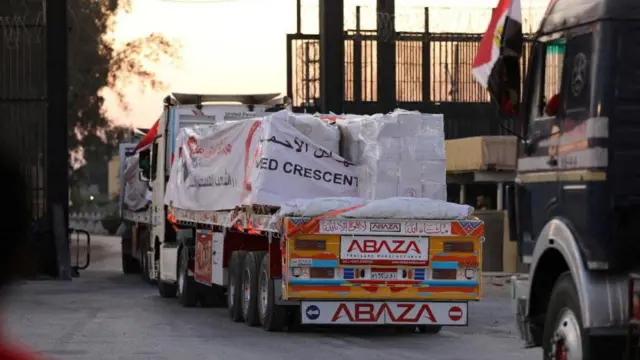 Image source, Reuters
Image source, Reuters
Israel was facinginternational outrage as images of emaciated children, accounts of peoplefainting from hunger and reports of Palestinians starving to death in Gazaspread across the world.
There was growing pressure from the UN and aidagencies, which have been warning of mass starvation in the territory, and evensome of Israel’s allies who have blamed the country’s restrictions on the entryand distribution of aid for this crisis.
Israel, which as anoccupying power has the obligation under international law to protectcivilians, has categorically rejected the allegations.
But it had blocked theentry of all humanitarian aid into the territory between March and May, in whatwas then described as a strategy to put pressure on Hamas to agree to aceasefire and hostage release deal, which did not happen. It was accused ofusing food as a weapon, a war crime, which it also denied.
Then, it created acontroversial new system for the distribution of supplies, which requirespeople to walk to a handful of militarised hubs, often at great risk.
It saidthe system, which largely bypassed the UN and other agencies with decades ofexperience, was needed to prevent the large-scale diversion of aid from Hamas,although it has never provided evidence that this was happening. The UNdescribed the mechanism as insufficient and inhumane, calling it “death traps”:it says more than 1,000 Palestinians have been killed while seeking aid underthe system.
As a result, alimited amount of food was getting in, and what was there was not reachingeveryone.
It is still not clear how much food will now enter Gaza, and to howmany people. For some, any help will probably arrive too late
Photos show some Gazans receiving aid supplies as pause beginspublished at 12:06 British Summer Time
We’ve just received some new pictures from northern Gaza, showing people in Beit Lahia carrying bags of aid.
This follows an announcement from Israel of a tactical pause in fighting in some areas to allow humanitarian aid to reach civilians.
Crowds were seen climbing onto aid trucks and carrying large sacks on their shoulders.
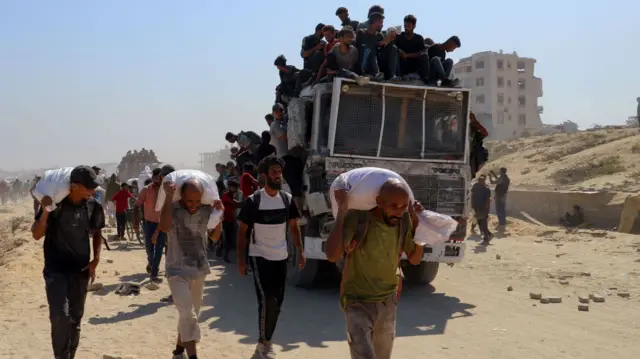 Image source, Reuters
Image source, Reuters
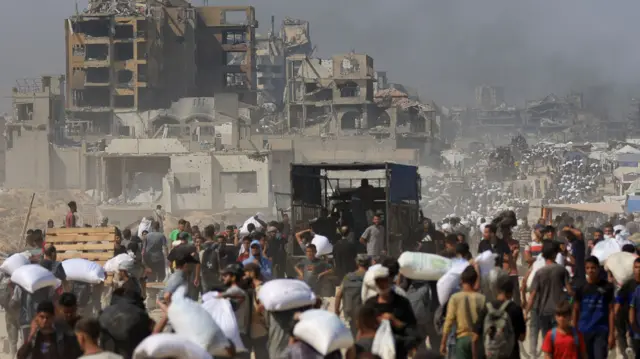 Image source, Reuters
Image source, Reuters
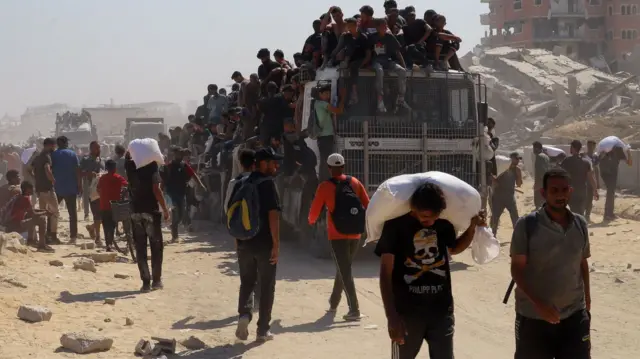 Image source, Reuters
Image source, Reuters


